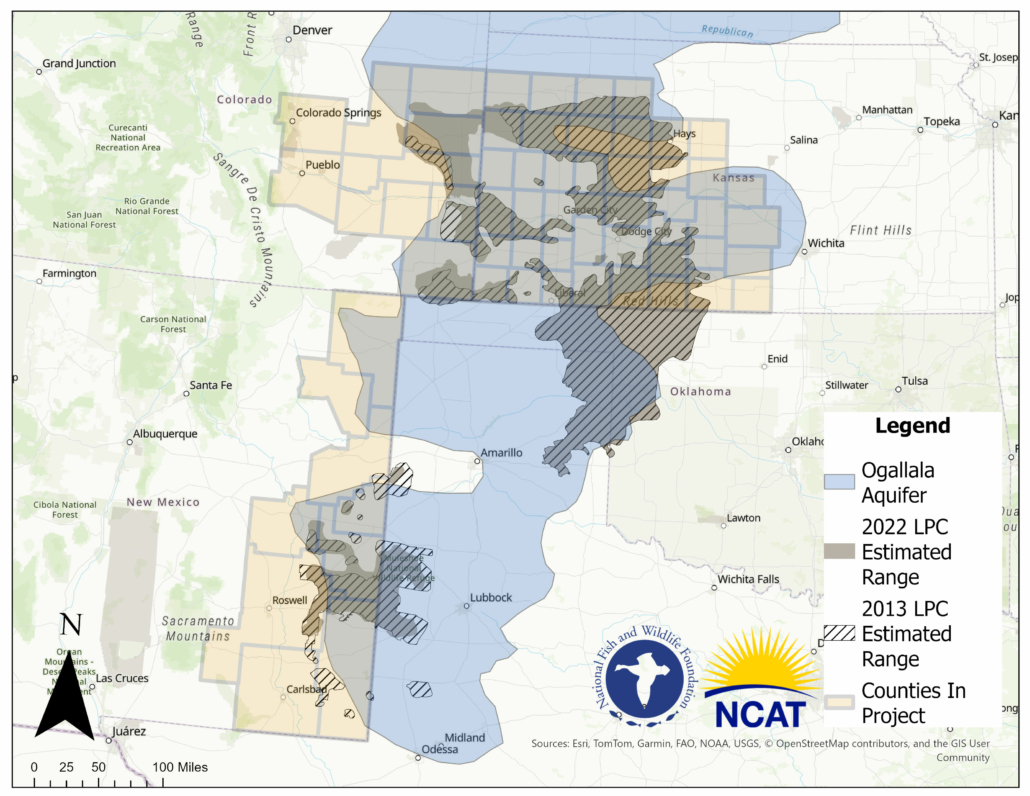Abundant Ogallala
Regenerative Agriculture for a Water-Scarce Future
NCAT is here to provide conservation planning and technical assistance to help farmers and ranchers foster conservation across the Southern Plains.
When it comes to the Southern Great Plains, conservation needs are diverse, the stakes are huge, and the outcomes will be dire if we fail to meet the challenges ahead. The Ogallala Aquifer supplies nearly all water for municipal, industrial, and agricultural uses in the region. The regional economy hinges on agriculture, yet at current pumping rates, more than a third of the Southern High Plains may be unable to support irrigation within the next 30 years. Playas, wetlands, and grasslands of the region support rare and declining wildlife such as the Lesser Prairie Chicken. Rapid, widespread adoption of regenerative agroecological practices is the most promising pathway to simultaneously conserve precious groundwater resources, enhance wildlife habitat, increase soil health, and improve long-term sustainability of ag operations and rural communities for the future. NCAT is here to provide conservation planning and technical assistance to help farmers and ranchers foster conservation across the Southern Plains.
Counties NWFW Ogallala Project Will Service
| New Mexico | Colorado | Kansas |
|---|---|---|
| Chaves, Curry, De Baca, Eddy, Harding*, Lea, Quay, Roosevelt, Union* | Baca, Bent*, Cheyenne, Crowley*, El Paso*, Kiowa, Kit Carson, Lincoln, Otero*, Prowers, Pueblo* | Barber, Barton*, Clark, Comanche, Edwards, Ellis, Finney, Ford, Gove, Graham, Grant, Gray, Freeley, Hamilton, Harper*, Haskell, Hodgeman, Kearny, Kingman*, Kiowa, Lane, Logan, Meade, Morton, Ness, Pawnee, Pratt, Reno*, Rice*, Rush, Russell, Scott, Seward, Sheridan, Sherman, Stafford, Stanton, Stevens, Thomas, Trego, Wallace, Wichita |

What is good for the (LP)Chicken is good for the soil.
Many conservation practices help build LPC habitat and soil simultaneously. Interested in adopting these practices?
What is good for the (LP)Chicken is good for the farmer.
With a little planning, good LPC habitat and farms can co-exist. All while keeping your water on your farm. Ready to make a plan?
What is good for the (LP)Chicken is good for the rancher.
Livestock and wildlife can flourish together with proper management that restores the soil sponge. Want to soak up more rain?
What is good for the (LP)Chicken is good for the bottom line.
Conservation practices have been proven to keep your natural resources in place and create resiliency through fluctuating rainfalls. Do you like keeping your money and resources in your control?
What is good for the (LP)Chicken is good for the environment.
The wider that conservation practices are implemented, the more successes we see both up and down stream. Want to join your neighbor in conservation land stewardship?
What is good for the (LP)Chicken is good for ALL.
Lesser Prairie Chicken, tomatoes, wheat, cows, farmers, ranchers, fisher men and women, nature enthusiasts, and water drinkers ALL benefit from conservation practices that regenerate land, keep natural resources in place, and increase LPC habitat. Sign up for your own conservation plan today.
“The lesser prairie-chicken’s decline is a sign our native grasslands and prairies are in peril.”
Amy Leuders, Southwest Regional Director for US Fish & Wildlife Service
This project is funded by the National Fish and Wildlife Foundation
This is a publication of the Abundant Ogallala: Regenerative Agriculture for a Water-Scarce Future in the Southern High Plains project, supported by the National Wildlife Fish and Wildlife Foundation under grant number 2004.24.081758. NCAT and NFWF are equal opportunity employers and service providers. ©2025 NCAT

